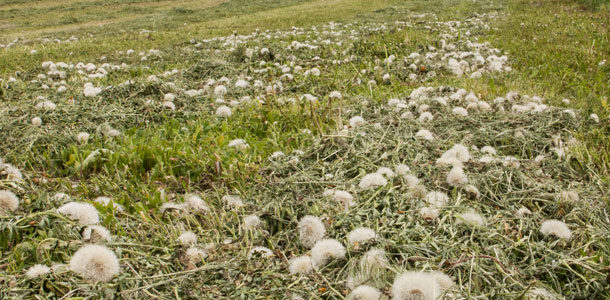Before deciding to spray these weeds, first consider whether or not they are actually causing economic damage. If you kill these weeds, you may harvest more actual alfalfa but total tonnage at first cutting might be less because you won’t have weeds to add weight.
If dairy quality hay is your objective, controlling these weeds might be very important due to their impact on forage quality, palatability and hay drydown. In some other livestock operations, though, these weeds may not cause serious problems so use of herbicides may not be cost effective.
If your alfalfa is a Roundup Ready variety, you have some flexibility in timing the application of Roundup. Don’t wait too long, though. If weeds get more than 3 inches tall or alfalfa begins to form a canopy, weed control may not be as effective.
Once conventional alfalfa starts growing, you can't control these weeds very well without hurting your alfalfa. However, if you treat alfalfa as soon as possible during this winter’s next spring-like weather, you can have cleaner, healthier alfalfa at first cutting.
Several herbicides can help control winter annual grasses and weeds in alfalfa. Herbicides that are used before alfalfa breaks dormancy include metribuzin (Sencor), Velpar, Sinbar and Karmex. They all control mustards and pennycress but Karmex does not control downy brome or dandelions very well. Metribuzin usually is the least expensive.
To be most successful, though, you must apply these herbicides before alfalfa shoots green-up this spring to avoid much injury to your alfalfa. During mild winter weather would be a great time. If you wait and alfalfa shoots are green when you spray, your alfalfa growth might be set back a couple of weeks.
If it does get late and alfalfa turns green before you can spray, switch your herbicide choice to either Pursuit or Raptor. These herbicides tend to cause less injury to your alfalfa.
Timing is crucial when controlling winter annual weeds in alfalfa. Get ready now, in the next few weeks before alfalfa greens up, to take advantage of nice weather when you get it. FG
Bruce Anderson, Ph.D. is an agronomy and forage specialist for the University of Nebraska – Lincoln.
PHOTO
Dandelions and other weeds can often be a problem in early cuttings of hay. Photo by Mike Dixon.









